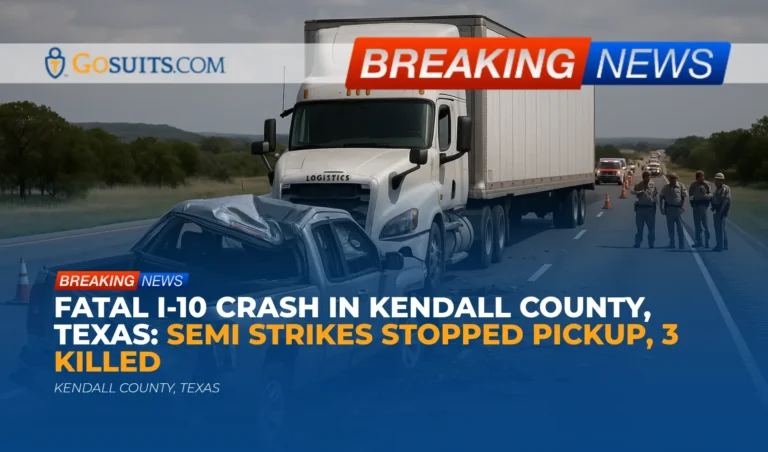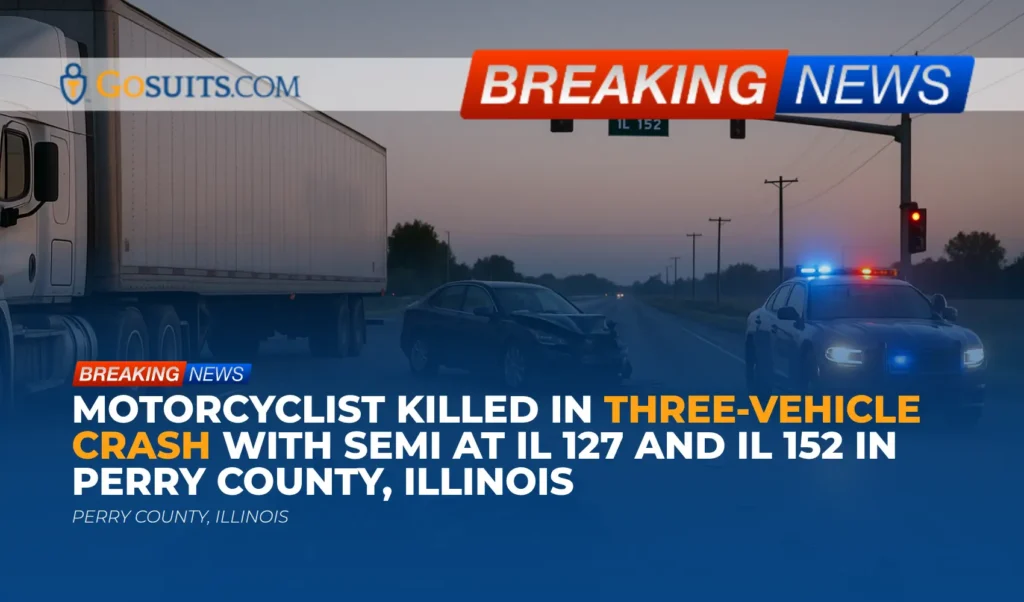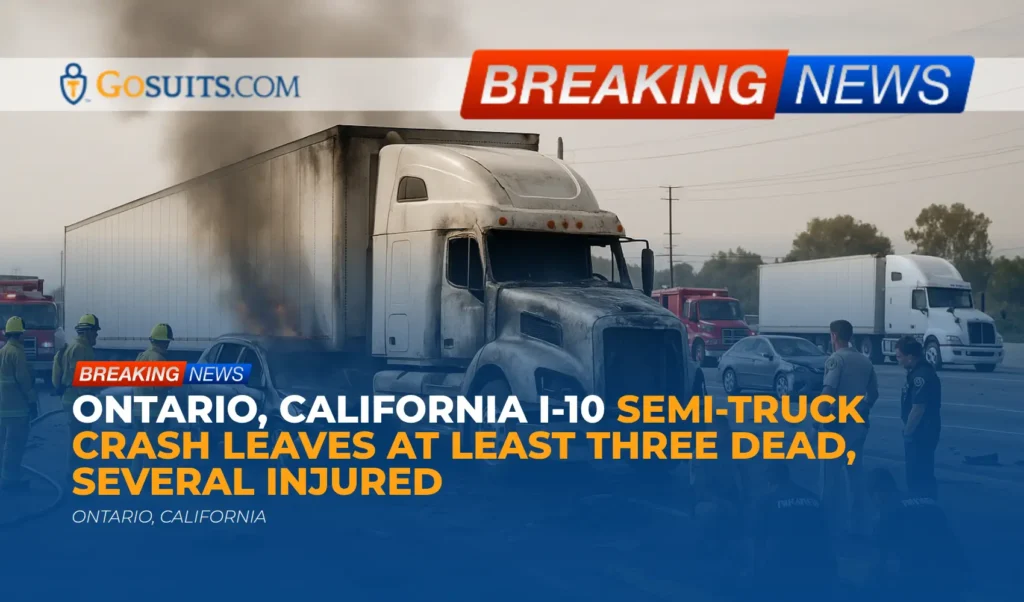- What We Know About the I-10 Crash in Kendall County
- Location, Timing, and Traffic Impact
- Agencies Involved and Official Notes
- Why Crashes Like This Happen: Stopped Vehicles and Tractor-Trailers
- Texas Civil Law Context for Families After a Deadly Crash
- Time-Sensitive Steps to Preserve Rights and Evidence
- How to Obtain Official Records and Information
- Insurance and Claims Considerations
- Safety Reminders for the Community
- Support and Assistance Resources
- Commentary from Gosuits Kendall County, Texas Personal Injury Attorney
- Why Taking Action Matters
What We Know About the I-10 Crash in Kendall County
Authorities report a devastating multi-fatality crash on Interstate 10 near mile marker 524 in Kendall County, Texas. Around 3:19 p.m., Texas Department of Public Safety Highway Patrol troopers responded to a major traffic collision. According to a preliminary account, a silver GMC Sierra pickup was stopped in the right travel lane for reasons that remain unknown. A truck tractor pulling a semi-trailer struck the stopped pickup. One 23-year-old adult and two children were pronounced deceased at the scene. A second adult and a female child were transported to a San Antonio hospital, with the child airlifted by helicopter; the extent of their injuries was not immediately available. Officials indicated the highway would reopen within about an hour after the announcement. Identification of the deceased had not yet been confirmed at the time of the report.
Early details in serious crashes are often incomplete. The cause of the pickup’s stop in the right lane, the speed and actions of the tractor-trailer, visibility, and other critical factors will typically be clarified only after full investigation, which may include scene mapping, data downloads from vehicle modules, and witness statements. Families should be aware that “preliminary” findings may change as evidence is collected.
Location, Timing, and Traffic Impact
The incident occurred near mile marker 524 on I-10 in Kendall County. Around 4 p.m., the Kendall County Sheriff’s Office announced that all westbound lanes were closed due to the fatal crash, with traffic diverted through Exit 524. Officials warned travelers to expect significant delays and requested that drivers avoid the area to allow first responders to work safely. In events like this, closures are common to allow for lifesaving measures, air medical operations, and detailed crash reconstruction.
Agencies Involved and Official Notes
Multiple agencies typically work together after a crash of this scale:
- Texas Department of Public Safety (DPS) Highway Patrol: DPS troopers investigate serious crashes on state highways and interstates. Information about the Highway Patrol’s role is available at the DPS site: Texas DPS Highway Patrol.
- Kendall County Sheriff’s Office: Assists with traffic control, scene security, and public information during road closures and diversions. County contact information is available at the Kendall County government website: Kendall County, Texas.
- Emergency Medical Services and Air Medical: Provide on-scene triage, transport to trauma centers, and coordination with area hospitals.
- Medical Examiner/Justice of the Peace: In Texas, fatalities outside a medical facility are reported to a medical examiner (if the county has one) or to a justice of the peace who may order an autopsy and manage death investigation procedures. This process ensures accurate determination of cause and manner of death.
Families and community members should expect additional updates from DPS or county officials as the investigation progresses. It is not unusual for identification and notification processes to take time, as officials must confirm details and notify next of kin.
Why Crashes Like This Happen: Stopped Vehicles and Tractor-Trailers
Crashes involving a stopped or disabled vehicle in a travel lane and an approaching heavy truck are among the most severe due to high closing speeds and the physics of large vehicles. Federal and state safety rules reflect the heightened risk and set duties for commercial drivers when their vehicles are stopped near or within a roadway.
Risk factors when a vehicle stops in a travel lane
- Limited stopping distance: Tractor-trailers require significantly longer distances to stop compared with passenger vehicles, especially at highway speeds and under heavy load.
- Visibility and conspicuity: If a vehicle is stopped in a live lane without hazard lights or warning devices, approaching traffic may have diminished time to perceive and react.
- Driver workload and distraction: Even momentary inattention can be catastrophic when a stopped vehicle is ahead.
- Night or glare conditions: Sun angle or after-dark conditions can reduce detection time.
Safety rules for stopped commercial vehicles
Federal regulation requires commercial drivers who stop on the roadway or shoulder to immediately activate hazard warning flashers and, within 10 minutes, place warning devices such as reflective triangles to alert approaching drivers. See 49 CFR 392.22 at the official eCFR: Stopped commercial vehicle warning requirements. These rules are designed to reduce secondary impacts when a large vehicle is disabled or stopped.
More broadly, hours-of-service rules and safe operation standards apply to commercial drivers to reduce fatigue and improve attentiveness; summaries are published by the Federal Motor Carrier Safety Administration: FMCSA Hours-of-Service overview.
Data on large-truck crashes
NHTSA’s national statistics show the outsized harm that can result from large truck collisions. In its Traffic Safety Facts on large trucks, NHTSA reports thousands of fatalities nationwide each year involving large trucks. See NHTSA’s publication for detailed data: NHTSA Large Trucks Traffic Safety Facts.
Move Over/Slow Down duties
Texas requires drivers to move over or slow down when approaching authorized vehicles stopped with lights activated on the shoulder or roadside. While that law primarily addresses approach to emergency and service vehicles, its core safety message is consistent: reduce speed and give space around incidents to protect lives. TxDOT explains these requirements here: Texas Move Over/Slow Down law.
Texas Civil Law Context for Families After a Deadly Crash
Every crash involves a unique set of facts. The notes below are general information about how Texas civil law often addresses serious traffic collisions. They are not a prediction of fault in this incident, and they are not legal advice.
Potential civil liability and duties
- Commercial driver and motor carrier: If a tractor-trailer driver failed to keep a proper lookout, maintain speed control, or follow safety regulations, liability may fall on the driver and the motor carrier that employs or uses the driver. Motor carriers can be responsible for negligent operation, hiring, training, supervision, vehicle maintenance, and regulatory compliance.
- Stopped vehicle considerations: If a vehicle is stopped in a live lane without adequate warning to approaching traffic, questions may arise about why the stop occurred and whether steps were taken to move to the shoulder, activate hazard lights, and warn others. Facts such as mechanical failure, sudden medical emergency, or other unavoidable circumstances can be relevant. Investigators typically review these elements before reaching conclusions.
- Roadway and environmental factors: Lighting, signage, and roadway conditions may be examined. Most highway collisions do not involve roadway defect claims, but investigators still consider the environment as part of a complete picture.
Comparative responsibility in Texas
Texas uses a proportionate responsibility system. Under Chapter 33 of the Texas Civil Practice and Remedies Code, damages can be reduced by a party’s percentage of responsibility, and a claimant who is found more than 50 percent responsible cannot recover. See the statute: Texas CPRC Chapter 33. This framework underscores the importance of a careful, evidence-based investigation.
Wrongful death and survival claims
After a fatal crash, certain close family members may bring a wrongful death action, and the decedent’s estate may bring a survival action for damages the person suffered before death. These claims are governed by Chapter 71 of the Texas Civil Practice and Remedies Code: Texas CPRC Chapter 71. The specifics of who can bring a claim, the damages available, and how proceeds are distributed are defined by statute and case law.
Statute of limitations
In many Texas personal injury and wrongful death matters, the general limitations period is two years, though exceptions and special rules can apply. See Texas CPRC § 16.003: Limitations periods. Because deadlines can bar claims, families often seek guidance early to understand the applicable timeline.
Insurance minimums for motor carriers
Interstate motor carriers must maintain minimum financial responsibility, typically at least $750,000 for for-hire carriage of nonhazardous property, with higher minimums for certain cargoes. FMCSA publishes these requirements here: FMCSA insurance requirements. Many carriers maintain higher limits, and multiple layers of coverage may apply, but policies are not public without formal requests or litigation.
Time-Sensitive Steps to Preserve Rights and Evidence
In the aftermath of a serious crash, evidence can be lost quickly. While every situation is different, the following general measures often help protect the fact-finding process. Consider speaking with a qualified attorney before taking these steps so that communications are protected and coordinated.
- Consult counsel before speaking with any insurer: Insurance adjusters, including your own insurer, may request recorded statements. People sometimes assume these are routine, but what is said can later be used to limit claims. It is prudent to consult an attorney first, understand your rights, and decide if and how to provide information.
- Preserve physical and digital evidence: Save phone photos, dashcam footage, and any communications related to the crash. Keep damaged items and do not authorize repairs or disposal without advice, as physical evidence can be crucial.
- Commercial vehicle data: Many trucks contain electronic control modules and telematics with speed, braking, and throttle data. Carriers control these systems, so timely preservation requests are important. Federal rules require retention of certain driver logs and supporting documents for limited periods; see 49 CFR Part 395 for hours-of-service recordkeeping: 49 CFR Part 395.
- Medical and funeral documentation: Keep all hospital records, transport bills, and funeral documentation, as these can be essential in insurance claims and potential civil actions.
- Witness information: If safe and appropriate, note names and contact information for witnesses. Law enforcement reports may later include this, but it can take time for reports to be released.

How to Obtain Official Records and Information
Official records help families understand what happened and are often needed for insurance and legal matters. Below are common sources for Texas crashes on interstates.
Texas crash reports
Most Texas crash reports are maintained by the Texas Department of Transportation’s Crash Records Information System (CRIS). Once available, a copy can be purchased online. TxDOT’s overview page explains eligibility and the request process: TxDOT Traffic Crash Reports. It can take days or weeks for a report to be finalized, and supplemental reports may follow.
Texas DPS public information
For records held by the Texas Department of Public Safety, the agency provides information on making public information requests. Start with the DPS division pages to identify the correct unit, such as the Highway Patrol: DPS Highway Patrol. Public information requests in Texas are governed by the Public Information Act; guidance for requestors is available from the Texas Attorney General: Texas Public Information Act guidance.
Kendall County contacts
For local questions about roadway closures, scene assistance, or records the county may hold, visit the county’s official website for department contacts, including the Sheriff’s Office and Justices of the Peace: Kendall County official site.
Medical examiner, justice of the peace, and autopsy information
In Texas, some counties use a medical examiner’s office, while others rely on justices of the peace to order autopsies and manage death investigations. When a person passes away at a hospital in another county, the medical examiner in that county may have jurisdiction over the autopsy. Families can contact:
- Kendall County Justices of the Peace: For deaths that occurred within Kendall County, the responsible justice of the peace can advise on autopsy orders and death investigation status. Contact information is available through the county site: Kendall County, Texas.
- Bexar County Medical Examiner’s Office: If a death occurred in San Antonio/Bexar County, the medical examiner may manage the postmortem examination and records. See: Bexar County Medical Examiner.
For certified death certificates, the Texas Department of State Health Services provides guidance and application options: Texas DSHS Death Records.
Towing and vehicle storage
Vehicles involved in serious crashes are often moved to a Vehicle Storage Facility. The Texas Department of Licensing and Regulation provides information on towing and release of vehicles, fee limits, and complaint processes: TDLR Towing and Vehicle Storage. Families seeking to retrieve personal items or arrange independent inspections may need proof of authority and should proceed carefully to preserve evidence.
Locating a commercial carrier
If a motor carrier’s identity is known, basic information may be available through FMCSA’s SAFER system using a USDOT or MC number: FMCSA SAFER Company Snapshot. Detailed policy information is not public, but the snapshot can help identify the carrier entity involved.
Insurance and Claims Considerations
Insurance issues after a fatal or catastrophic crash can be complex. Collisions that involve multiple victims, a passenger vehicle, and a commercial truck may implicate several layers of coverage, including the truck’s liability policy, potential excess policies, and the passenger vehicle’s own coverages such as uninsured/underinsured motorist (UM/UIM) and personal injury protection (PIP).
- Speak with an attorney before reporting to any insurer: Insurance companies may ask for recorded statements, authorizations, or quick settlements. It is prudent to consult an attorney first to understand obligations and risks. Statements made to insurers can be used later, and some authorizations may grant access to broad medical histories unrelated to the crash.
- Preserve policy documents: Keep all auto policies, declarations pages, and any umbrella policies. If policies cannot be found, request replacement copies from your agent after consulting with counsel.
- Be cautious with social media: Carriers sometimes review public posts. Consider pausing posting about the event and review privacy settings.
- Medical billing and liens: Hospitals and insurers may assert liens or reimbursement claims. Understanding the order of payment and lien rules early can prevent surprises later.
Safety Reminders for the Community
While investigations will determine the causes in this tragedy, the following reminders are proven to reduce harm on Texas roadways:
- Move to the shoulder if safely possible: If a vehicle loses power or has a flat, steer toward the shoulder or a safe refuge. Avoid stopping in a live lane whenever feasible.
- Use hazard lights and warning devices: Activate hazard flashers immediately. If stopped near a travel lane, set reflective triangles or flares when it is safe to do so. Commercial drivers must follow the federal warning requirements noted above.
- Call for assistance: If a vehicle cannot be moved, call 911 and request help. Consider waiting outside and away from traffic if it is safe to exit.
- Slow down and give space: Approaching any roadside incident, reduce speed and change lanes away from the scene when safe, consistent with Texas’s Move Over/Slow Down rule described by TxDOT: Move Over/Slow Down.
Support and Assistance Resources
Traumatic events affect families and the broader community. Support can make a meaningful difference during the first days and weeks.
- Crisis support: The 988 Suicide and Crisis Lifeline is available 24/7 for anyone experiencing emotional distress or needing support: SAMHSA 988 Lifeline.
- Official updates: Texas DPS and Kendall County government channels may provide updates as the investigation progresses. See DPS Highway Patrol: DPS Highway Patrol and the county site for department contacts: Kendall County.
- Vital records: For death certificates and guidance, see the Texas Department of State Health Services: DSHS Death Records.
Commentary from Gosuits Kendall County, Texas Personal Injury Attorney
Our hearts are with the families and community members affected by this tragic I-10 collision. The loss of a young adult and two children is heartbreaking, and we extend sincere sympathy to those grieving and to those who were injured. The information here is offered for general educational purposes to help the public understand the civil-law landscape that often applies after serious highway crashes.
Based on the preliminary account, a critical question is why a pickup came to a stop in a live travel lane and what, if any, warnings were visible to approaching traffic. Equally important is whether the tractor-trailer driver maintained an assured clear distance and a proper lookout, and whether speed, visibility, or line-of-sight played a role. In cases involving commercial vehicles, compliance with federal safety rules, driver attentiveness, and timely hazard recognition are central issues. Thorough investigation guided by objective data, scene evidence, and witness accounts is essential before drawing conclusions about responsibility.
In our experience, insurance carriers and large companies move quickly after a major crash to shape the narrative. Representatives may contact people for statements or offer early settlements before the full scope of harm is understood. This timing can take advantage of shock, grief, and the natural desire to resolve practical worries. It is wise to pause and get informed. Understanding how medical bills, funeral costs, lost support, and future needs fit into Texas law can help avoid decisions that unintentionally limit options later.
A no-cost consultation with a seasoned personal injury attorney can provide clarity about rights, deadlines, and the kinds of evidence that matter most, such as truck electronic data, driver logs, and corporate safety records. Because these materials can be overwritten or discarded with ordinary business practices, timely action to request preservation is often crucial. Speaking with counsel before interacting with insurers helps ensure that communications are accurate and that you do not inadvertently give up protections.
Why Taking Action Matters

What to do
- Document and organize: Collect all records and communications, including photos, hospital paperwork, transport bills, and any correspondence from insurers.
- Request official records: Plan to obtain the Texas crash report when available through TxDOT’s CRIS system and ask about autopsy or death investigation status from the appropriate county office.
- Preserve evidence: Avoid repairing or disposing of a vehicle or personal items without guidance. Preserve digital media and keep a written timeline of events and symptoms.
- Seek informed guidance: Before giving any recorded statement or signing any medical or records authorization for an insurer, consult with an attorney to understand rights and potential consequences.
Why now
- Evidence is time-sensitive: Commercial driver logs, telematics, and camera footage may be routinely overwritten. Prompt preservation requests can prevent loss.
- Deadlines affect options: Texas law imposes strict timelines for civil claims. Early clarity about applicable deadlines helps protect the ability to seek accountability.
- Accurate financial picture: Early coordination helps track medical costs, funeral expenses, lost income, and future needs so that any insurance discussions reflect the full impact.
- Reduce stress: A clear plan for records, communications, and next steps can reduce uncertainty during a difficult time.
Key Government and Academic Sources Referenced
- Texas Department of Public Safety – Highway Patrol
- TxDOT – Traffic Crash Reports (CRIS)
- Kendall County, Texas – Official Website
- Bexar County Medical Examiner
- Texas DSHS – Death Records
- TDLR – Towing and Vehicle Storage
- 49 CFR 392.22 – Warning Devices for Stopped Commercial Vehicles
- FMCSA – Hours-of-Service Summary
- NHTSA – Large Trucks Traffic Safety Facts
- TxDOT – Move Over/Slow Down Law
- Texas CPRC Chapter 71 – Wrongful Death
- Texas CPRC §16.003 – Limitations
- Texas CPRC Chapter 33 – Proportionate Responsibility
- FMCSA – Motor Carrier Insurance Requirements
- SAMHSA – 988 Suicide & Crisis Lifeline






